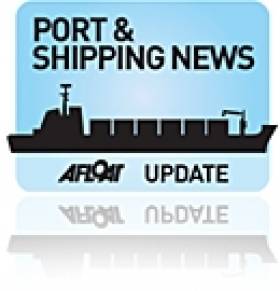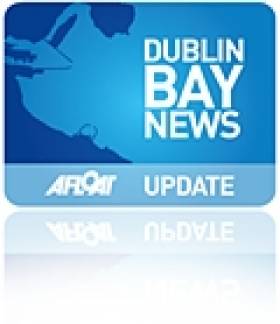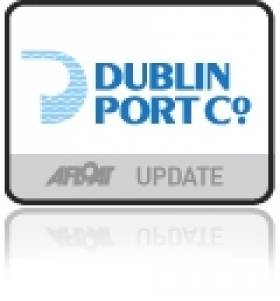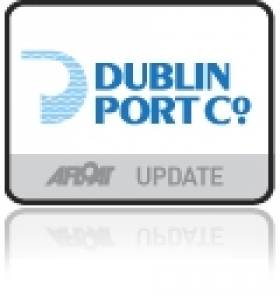Displaying items by tag: Dublin Port Company
#CruiseDublin – The Dublin Port Company has invited submissions from companies interested in developing the cruiseship business at the nation's largest port.
The port which has the biggest cruise business on the island of Ireland and in attracting many major cruise lines has potential for further growth.
DPC has provided port infrastructure in other sectors of the port to be operated by private sector companies working in competitive markets.
The port is currently looking to follow a similar approach in relation to its cruise business and is seeking to enter a multi-annual relationship with a suitable partner. This partner is to grow the cruise business both of the port and for operators in the tourism sector.
For further information including contact details and date for submissions, visit this LINK.
Dublin Port and One51 to Sell Greenore Port
#GreenorePort – Today's Irish Times reports that State-owned Dublin Port Company and investment company One51 are on the brink of selling Greenore Port in Co. Louth to a new owner for a figure in the low single-digit millions.
The sale of the strategically located port on Carlingford Lough is being handled by IBI Corporate Finance, which is in the final stages of closing the sale of the port.
The port is owned equally by Dublin Port Company and One51 via a company called Renore Ltd, which was set up to acquire the operations of the port in April 2002. To read more of this development, click the article Here.
Dublin Port Company Pays €8m Dividend to the State
#dublinport – Dublin Port Company has paid a dividend of €8 million to the State based on its financial results for the year ended 31 December 2013. The payment is in line with the company's commitment to making a dividend payment of 30% of profit after tax, annually.
It follows the company's total dividend payment of €15 million last year, which included a once-off special dividend of €8 million, and brings total dividend payments to the State by the port to €69.8 million over the last eight years.
Minister Varadkar said: "I am delighted that Dublin Port is in a position to make this dividend payment of €8 million. I commend Dublin Port Company on its financial performance in 2013. The fact that Dublin Port is capable of making a significant return to the Exchequer is testament to the Board, management and employees. The port continues to play a crucial role in the economy at national and local level and the continued strength of the company's finances positions it well to deliver on its planned key infrastructural developments.
"I attach particular importance to the payment of dividends by commercial State enterprises. Dividend payments act as a useful benchmark for financial performance, and also serve to remind all involved that the State is a full shareholder. Like any shareholder, the State therefore expects to see a return on its assets."
Ms Lucy McCaffrey, the Company's Chairperson said: "I am delighted that Dublin Port Company continues to be in a position to meet the target set out by the Minister in the National Ports Policy which requires that profitable commercial state companies should pay a financial dividend to the State at 30% of after-tax profits. It is particularly encouraging that the strength of the company's profitability and financial position ensures that we will be in a position to continue to meet this target in the coming years while also delivering on our capital investment programme which we are confident will ensure that the country's main gateway for international trade will have the infrastructure and capacity to facilitate growth and recovery in the economy."
#riversidefestival – Dublin Port Company and the Docklands Business Forum today launched Dublin Port's 2014 "Riverfest" – Ireland's premier riverside and sailing festival. The festival, which is in its second year, will take place over the June bank holiday weekend (Saturday 31st May – Monday, 2nd June) along Dublin's historic North Wall Quay and will include a mix of seafaring events and quayside activities with fun for all the family.
The River Liffey will take centre stage, as the three day festival is expected to be one of the biggest family-friendly events this weekend, attracting thousands of Dubliners and visitors quayside to enjoy a huge array of activities including the arrival of six spectacular tall ships, two pirate ships featuring pirate re-enactments, tug boat "dance" demonstrations, river kayaking and free tours of the Jeanie Johnston Tall Ship, culminating in a Parade of Sail on Monday.
To complement the water activities, the quayside will feature performances from shanty singers, high wire aerial acts, art and circus workshops, with food markets and a family funfair taking place from the Samuel Beckett Bridge to the East Link Bridge.
This year the festival will also feature the magnificent Georgian National Ballet "Sukhishvili", as well as their Georgian counterparts, the Rustavi Choir. The Ballet has toured five continents, holding over 10,000 performances watched by over 50 million people and this will be the first time for the Ballet to perform in Ireland.
Commenting, Eamonn O'Reilly, Chief Executive of Dublin Port Company, said, "Riverfest is a celebration of Dublin as a port city, our rich maritime traditions and culture, and the age-old ties between Dublin Port and city life. The three day festival promises to be a fun and colourful event for all the family in a beautiful part of the city, with both on and off-water attractions and I would encourage all Dubliners and visitors to come and join us in the celebrations."
The full programme of activity includes:
Saturday 31st May
11am-6pm
DJ
11am-6pm
Food Markets
11am-6pm
Carnival
11am-6pm
Aerial Acts
11am-6pm
Street Theatre
11am-6pm
Shanty Singers
11am-6pm
Children's Art & Circus Workshops
11am-6pm
Jeanie Johnston – Free Tours
11am-6pm
Moira Sweeney's "Rhythm of a Port" Exhibition
11am-6pm
Come Try It – River Kayaking
Saturday's Key Programmed Events
11.30am
Tugboat Dance
12.30pm
Pirate Re-enactment 1
1.30pm
Georgian Singers on Stage
2.30pm
Tugboat Dance
3.30pm
Pirate Re-enactment 2
4.30pm
Georgian Ballet on Stage
Sunday 1st June
11am-6pm
DJ
11am-6pm
Food Markets
11am-6pm
Carnival
11am -6pm
Aerial Acts
11am-6pm
Street Theatre
11am-6pm
Shanty Singers
11am-6pm
Children's Art & Circus Workshops
11am-6pm
Jeanie Johnston – Free Tours
11am-6pm
Moira Sweeney's "Rhythms of a Port"
Exhibition
11am-6pm
Come Try It – River Kayaking
Sunday's Key Programmed Events
11.30am
Tugboat Dance
12.30pm
Pirate Re-enactment 1
1.30pm
Georgian Singers on Stage
2.30pm
Tugboat Dance
3.30pm
Pirate Re-enactment 2
4.30pm
Georgian Ballet on Stage
8.30pm -10.30pm The Admiral's Other Ball, The Cill Airne
Monday 2nd June
11am-6pm
DJ
11am-6pm
Food Markets
11am-6pm
Carnival
11am-6pm
FM104 Road Hog
11am-6pm
Street Theatre
11am-6pm
Shanty Singers
11am-6pm
Children's Art & Circus Workshops
11am-6pm
Jeanie Johnston – FREE TOURS
11am-6pm
Moira Sweeney's "Rhythms of a Port" Exhibition
11am-6pm
Aerial Acts
11am-6pm
Come Try It – River Kayaking
Monday's Key Programmed Events
11.30am
Tugboat Dance
12.30pm
Pirate Re-enactment 1
1.30pm
Georgian Singers on Stage
2.30pm
Tugboat Dance
3.30pm
Parade of Sail – Ships Leaving
4.30pm
Georgian Ballet on Stage – Finale
#dublinbay – The first phase of a safety sign roll out in Dublin Bay has just been launched. This phase involves 31 signs located along the north Dublin coastline at Ring Buoys and Bathing Shelters. Each sign will have its location displayed; this aims to improve the efficiency of the response of the emergency services when they receive an urgent call for help. A problem often encounter by the Coast Guard is knowing where the exact location of an emergency is, if a casualty is in the water or on a beach directing a lifeboat, helicopter or ground crew to a scene needs to be done without delay. The project is a joint initiative between Dublin Port Company, the Irish Coast Guard and Dublin City Council and is hoped will save time and lives in rescues on the Dublin Bay coastline.
Colin Murray, Officer in Charge, Irish Coast Guard station at Howth noted "Often time is the enemy when it's comes to coastal emergencies, we need to get to the location of the casualty as soon as possible and minimise the time needed to find them. In the case of tourists visiting an area they may not be aware of the correct name of the area they're in, even locals trying to describe what part of Dollymount beach they're on can be difficult. The new signs will help the emergency services with that response".
The Lord Mayor commented that "I very much welcome this initiative between the parties concerned, all working together to come up with a solution. Coming into the summer it's important to ensure the emergency services have the best information to hand quickly to ensure a speedy response, I've no doubt having the location on the signs will make an important difference".
Pat Ward, Dublin Port Company's Head of Corporate Services remarked "While Dublin Bay provides the key commercial artery for trade on the island of Ireland, it is also renowned for its recreational and leisure craft activities. The importance of accurate information in an emergency situation is critical and todays initiative plays a huge part in assisting the public and our emergency services when called upon."
Remember if see someone in trouble on the beach, cliff or water act quickly and call that Coast Guard at 112 right away. A false alarm with good intention is always well received by the Coast Guard; a call that's too late could mean tragedy.
Dublin Port Company to Pay Additional €8m Dividend to State
#DublinPORT - Minister for Transport, Leo Varadkar has announced Dublin Port Company will pay an additional dividend of €8m to the State during 2013, bringing the company's total dividend to €15m.
The decision to pay the second special dividend was taken by the Board at its meeting of 1st July 2013 and followed on from a request from the shareholders at the Company's Annual General Meeting that it consider making an additional contribution in line with requests made generally of the State commercial sector.
Responding to this announcement, the Minister said: "I am delighted that Dublin Port is in a position to make this special additional dividend of €8m, on top of the normal dividend payments of €7m already made this year.
"As part of the National Ports Policy which I launched earlier this year, all of our State commercial port companies were asked to set up a clear dividend policy. Arising from this, Dublin Port has set out to the Department its dividend policy for the coming years.
Today's special dividend payment forms part of that. In future years, Dublin Port has committed to making a dividend payment of 30% of distributable profits.
"The fact that Dublin Port is capable of making such a significant return to the Exchequer is testament to the Board, management and employees of this vitally important State asset and I thank the Company for this special dividend contribution."
Lucy McCaffrey, the Company's Chairperson said: "I am delighted that it is possible this year for Dublin Port Company to be in a position to look after the interests of our shareholder to the extent that we have".
The decision to declare the additional €8m special dividend was taken after consideration of the other calls on the Port's cash, particularly our need to invest for the future.
Dublin Port Company is profitable and has a relatively low debt burden and remains in a position in the coming years to fund major infrastructural investment.
"Our commitment to our shareholder and to investing for the future parallels our ongoing commitment to control and reduce expenditure and keep Dublin Port competitively priced for our customers."
Irish Ports Association Conference Heads for Dublin
#IRISHportsConference - As previously reported the 2013 Irish Ports Association (IPA) Conference on 27 September in Dublin is to be hosted by Dublin Port Company.
The annual event precedes the UK's British Ports Association which takes place next month.
This year, the IPA conference is to be held in the Gibson Hotel, Dublin which is close to The O2 Arena located within the 'Docklands' quarter that borders the port estate.
The conference will see the launching of the new National Ports Policy. In addition the conclusion by the Irish Competition Authority of a review of the ports sector and the publication by the EU Commission of a proposed ports Regulation. All of these create challenges for Irish ports whose efficiency and capacity is crucial to support international trade in goods.
Core themes of the IPA conference are ports policy, practice and planning. An elite panel of national and international speakers will not only examine recent policy developments but also to present examples from around the world (UK, Denmark, Greece and Chile) as to how ports elsewhere have adapted and responded to changing regulatory environments.
For further information on the conference, programme and bookings visit: ipadublin2013.com
Dublin Port Company Publish Annual Report & Accounts 2012
#DublinPort – The Dublin Port Company have published their Annual Report & Accounts for 2012 following a presentation of the accounts by Minister for Transport Mr. Leo Varadker to the Government at cabinet level last week.
As previously reported on Afloat.ie, the state's largest port launched a Masterplan last year that set out the development of Dublin Port's for the period from 2012 to 2040.
The 30 year Masterplan costing €600m presented a vision for future operations at the port and critically examines how existing land use can be used for the efficient running of the port through exporting and importing merchandise.
Dublin Port Company to pay €7m Dividend to the State
#DublinPortAGM – At the AGM of the Dublin Port Company today, it was announced that the port will pay a €7m dividend to the State in June 2013 based on its financial results for the year ended 31 December 2012.
The dividend represents a distribution of 30.7% of profit after tax and brings total dividend payments to the State to €53.8m over the last seven years.
While there were headline reductions in Turnover and Profit after tax, the underlying profitability of the business remained strong in 2012 with Operating Profit increasing by 4.6% from €27.8m to €29.1m.
At today's AGM the Annual Report for 2012 was presented to the Company's shareholders in advance of publication later this year after it has been laid before the Houses of the Oireachtas.
Speaking about the financial performance of Dublin Port Company for 2012, Minister for Transport, Tourism and Sport Leo Varadkar said: "I commend Dublin Port Company on its financial performance in 2012 and for once again paying a dividend to taxpayers. Dublin Port is an exemplary company which has consistently paid a dividend to the State at or above the level expected by Government.
The Port plays a crucial role for the economy at local and national level, which was acknowledged in the Government's recently published National Ports Policy."
Addressing Dublin Port Company's AGM, Ms Lucy McCaffrey, the Company's Chairperson said: I was pleased to present the company's annual report for 2012 to our shareholders and to confirm to the representatives of the Minister for Transport, Tourism and Sport and Minister for Public Expenditure and Reform that the company will pay a dividend of €7m to the State in June 2013.
The continued strength of the company's finances will ensure that the company is well positioned to deliver the key infrastructural developments envisaged in the Masterplan 2012-2040 which the company launched last year.
Plans for Bremore Port Project in Deep Water
#BremorePort – It appears that plans for the proposed €350m development of the deep-water port at Bremore, near Balbriggan, Co. Dublin has been effectively shot down under the government's new ports policy blueprint.
The proposed port was to be developed to provide support for Drogheda and Dublin ports.
A government source confirmed that the new policy indicated that "there was no need for new capacity development and that any main developments should be done at Dublin, Cork or Shannon, so it's unlikely that Bremore will be progressed."
The news has been greeted as a blow to the local economy by Balbriggan Chamber of Commerce.For more on this story the NorthCountyLeader.ie has a report.








































































